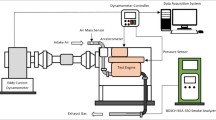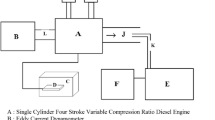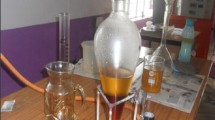Abstract
This work presents the effect of the ternary oxygenated additive on diesel biodiesel blended fuel to evaluate the engine characteristics. The Calophyllum inophyllum trees being abundant in India can lessen the dependence on petroleum imports to a specific extent. Methyl tertiary butyl ether is used as an oxygenated additive for the ternary blends preparation as 5–20% by volume. Seven blends of neat baseline diesel, biodiesel (Calophyllum inophyllum Methyl Ester), a blend of diesel (50%)-biodiesel (50%), a blend of diesel (50%)-biodiesel-methyl tert-butyl ether (5, 10, 15, and 20%) are prepared which are tested on a single cylinder, constant speed diesel engine. The experimental results were revealed that the replacement of biodiesel by MTBE has shown a slight reduction in brake thermal efficiency with a slight increase in brake-specific fuel consumption. Further, the MTBE addition in ternary blends reduced the unburned hydrocarbon, CO, and NOx by 63.9, 6.4, and 3.37% respectively. In addition, the carbon dioxide emission is almost similar to diesel fuel at a higher addition of MTBE with diesel-biodiesel blend. In the combustion point of view, the addition of 5% MTBE resulted in 3.49 and 5.1% reduction of peak pressure and heat release rate are observed as compared to diesel fuel. Critical analysis in combustion aspects is also carried out and it is witnessed with prolonged ignition delay during MTBE addition with diesel-biodiesel blends.















Similar content being viewed by others
Abbreviations
- CI:
-
Compression ignition
- CIME:
-
Calophyllum inophyllum methyl ester
- DEE:
-
Diethyl ether
- MTBE:
-
Methyl tertiary-butyl ether
- CO:
-
Carbon monoxide
- CO2 :
-
Carbon dioxide
- BTE:
-
Brake thermal efficiency
- BSFC:
-
Brake-specific fuel consumption
- BSEC:
-
Brake-specific energy consumption
- B100:
-
100% Biodiesel (Calophyllum inophyllum)
- D50B50:
-
50% diesel + 50% biodiesel
- D50B45DEE5:
-
50% diesel + 45% biodiesel + 5% diethyl ether
- D50B40DEE10:
-
50% diesel + 40% biodiesel + 10% diethyl ether
- D50B45MTBE5:
-
50% diesel + 45% biodiesel + 5% methyl tertiary-butyl ether
- D50B40MTBE10:
-
50% diesel + 40% biodiesel + 10% methyl tertiary-butyl ether
- HC:
-
Hydrocarbons
- NOx :
-
Oxides of nitrogen
- ppm:
-
Parts per million
References
Alagu K, Nagappan B, Jayaraman J & GnanaDhas AA (2018). Impact of antioxidant additives on the performance and emission characteristics of CI engine fuelled with B20 blend of rice bran biodiesel. Environ Sci Pollut Res, pp.1–11
Ali OM, Mamat R, Masjuki HH, Abdullah AA (2016) Analysis of blended fuel properties and cycle-to-cycle variation in a diesel engine with a diethyl ether additive. Energy Convers Manag 108:511–519
Alptekin E (2017) Evaluation of ethanol and isopropanol as additives with diesel fuel in a CRDI diesel engine. Fuel 205:161–172
Arcoumanis C, Bae C, Crookes R, Kinoshita E (2008) The potential of di-methyl ether (DME) as an alternative fuel for compression-ignition engines: a review. Fuel 87(7):1014–1030
Arumugam A, Ponnusami V (2019) Biodiesel production from Calophyllum inophyllum oil a potential non-edible feedstock: an overview. Renew Energy 131:459–471
Ashok B, Nanthagopal K, Jeevanantham AK, Bhowmick P, Malhotra D, Agarwal P (2017) An assessment of Calophyllum inophyllum biodiesel fuelled diesel engine characteristics using novel antioxidant additives. Energy Convers Manag 148:935–943
Atabani AE, da Silva César A (2014) Calophyllum inophyllum L.—a prospective non-edible biodiesel feedstock. Study of biodiesel production, properties, fatty acid composition, blending and engine performance. Renew Sust Energ Rev 37:644–655
Atabani AE, Silitonga AS, Ong HC, Mahlia TMI, Masjuki HH, Badruddin IA, Fayaz H (2013) Non-edible vegetable oils: a critical evaluation of oil extraction, fatty acid compositions, biodiesel production, characteristics, engine performance and emissions production. Renew Sust Energ Rev 18:211–245
Awad OI, Mamat R, Noor MM, Ibrahim TK, Yusri IM, Yusop AF (2018) The impacts of compression ratio on the performance and emissions of ice powered by oxygenated fuels: a review. J Energy Inst 91(1):19–32
Cataluña R, Dalávia D, Da Silva R, Menezes E, Venturi V, Wagner R (2011) Acceleration tests using gasolines formulated with di-TAE, TAEE and MTBE ethers. Fuel 90(3):992–996
Cerri T, D’Errico G, Onorati A (2013) Experimental investigations on high octane number gasoline formulations for internal combustion engines. Fuel 111:305–315
Chauhan BS, Kumar N, Cho HM (2010) Performance and emission studies on an agriculture engine on neat Jatropha oil. J Mech Sci Technol 24(2):529–535
Das D, Kumar A, Yadav A (2018) Evaluation of performance, emission and combustion characteristics of a CI engine fueled with karanja biodiesel and diethyl ether blends. Biofuels 9(1):89–94
Donahue RJ, Foster DE (2000) Effects of oxygen enhancement on the emissions from a DI diesel via manipulation of fuels and combustion chamber gas composition (No. 2000–01-0512). SAE Technical Paper
Jaichandar S, Annamalai K (2013) Combined impact of injection pressure and combustion chamber geometry on the performance of a biodiesel fueled diesel engine. Energy 55:330–339
Jiaqiang E, Liu T, Yang WM, Li J, Gong J, Deng Y (2016) Effects of fatty acid methyl esters proportion on combustion and emission characteristics of a biodiesel fueled diesel engine. Energy Convers Manag 117:410–419
Kajitani S, Usisaki H, Clasen E, Campbell S, & Rhee KT (1994). MTBE for improved diesel combustion and emissions. SAE Technical Paper No. 941688
Kalsi SS, Subramanian KA (2017) Effect of simulated biogas on performance, combustion and emissions characteristics of a bio-diesel fueled diesel engine. Renew Energy 106:78–90
Lamani VT, Yadav AK, Narayanappa KG (2017) Influence of low-temperature combustion and dimethyl ether-diesel blends on performance, combustion, and emission characteristics of common rail diesel engine: a CFD study. Environ Sci Pollut Res 24(18):15500–15509
Lešnik L, Vajda B, Žunič Z, Škerget L, Kegl B (2013) The influence of biodiesel fuel on injection characteristics, diesel engine performance, and emission formation. Appl Energy 111:558–570
Liu H, Wang Z, Zhang J, Wang J, Shuai S (2017) Study on combustion and emission characteristics of polyoxymethylene dimethyl ethers/diesel blends in light-duty and heavy-duty diesel engines. Appl Energy 185:1393–1402
Miyamoto N, Ogawa H, Nurun NM, Obata K, & Arima T (1998). Smokeless, low NOx, high thermal efficiency, and low noise diesel combustion with oxygenated agents as main fuel(No. 980506). SAE technical paper
Monirul IM, Masjuki HH, Kalam MA, Mosarof MH, Zulkifli NWM, Teoh YH, How HG (2016) Assessment of performance, emission and combustion characteristics of palm, jatropha and Calophyllum inophyllum biodiesel blends. Fuel 181:985–995
Mosarof, M. H., Kalam, M. A., Masjuki, H. H., Alabdulkarem, A., Ashraful, A. M., Arslan, A., ... & Monirul, I. M. (2016). Optimization of performance, emission, friction and wear characteristics of palm and Calophyllum inophyllum biodiesel blends. Energy Convers Manag, 118, 119–134
Nanthagopal K, Ashok B, Raj RTK (2016) Influence of fuel injection pressures on Calophyllum inophyllum methyl ester fuelled direct injection diesel engine. Energy Convers Manag 116:165–173
Nanthagopal K, Ashok B, Tamilarasu A, Johny A, Mohan A (2017) Influence on the effect of zinc oxide and titanium dioxide nanoparticles as an additive with Calophyllum inophyllum methyl ester in a CI engine. Energy Convers Manag 146:8–19
Nanthagopal K, Ashok B, Saravanan B, Patel D, Sudarshan B, Ramasamy RA (2018) An assessment on the effects of 1-pentanol and 1-butanol as additives with Calophyllum Inophyllum biodiesel. Energy Convers Manag 158:70–80
Natarajan M, Frame EA, Naegeli DW, Asmus T, Clark W, Garbak J, ... & Wallace JP (2001). Oxygenates for advanced petroleum-based diesel fuels: Part 1. Screening and selection methodology for the oxygenates. SAE Technical Paper No. 2001–01-3631
Ong HC, Masjuki HH, Mahlia TMI, Silitonga AS, Chong WT, Leong KY (2014) Optimization of biodiesel production and engine performance from high free fatty acid Calophyllum inophyllum oil in CI diesel engine. Energy Convers Manag 81:30–40
Ong ZC, Mishani MBM, Chong WT, Soon RS, Ong HC, Ismail Z (2017) Identification of optimum Calophyllum inophyllum bio-fuel blend in diesel engine using advanced vibration analysis technique. Renew Energy 109:295–304
Praveen A, Rao GLN, & Balakrishna B (2017). Performance and emission characteristics of a diesel engine using Calophyllum inophyllum biodiesel blends with TiO2 nanoadditives and EGR. Egyp J Petroleum
Rahman SA, Masjuki HH, Kalam MA, Abedin MJ, Sanjid A, Sajjad H (2013) Production of palm and Calophyllum inophyllum based biodiesel and investigation of blend performance and exhaust emission in an unmodified diesel engine at high idling conditions. Energy Convers Manag 76:362–367
Rajamohan S, Kasimani R. (2018a). Analytical characterization of products obtained from slow pyrolysis of Calophyllum inophyllum seed cake: study on performance and emission characteristics of direct injection diesel engine fuelled with bio-oil blends. Environ Sci Poll Res, 1–6
Rajamohan S, Kasimani R. (2018b). Studies on the effects of storage stability of bio-oil obtained from pyrolysis of Calophyllum inophyllum deoiled seed cake on the performance and emission characteristics of a direct-injection diesel engine
Rakopoulos DC, Rakopoulos CD, Giakoumis EG, Dimaratos AM (2012) Characteristics of performance and emissions in high-speed direct injection diesel engine fueled with diethyl ether/diesel fuel blends. Energy 43(1):214–224
Ramakrishnan P, Kasimani R, Peer MS, Rajamohan S (2018) Assessment of n-pentanol/Calophyllum inophyllum/diesel blends on the performance, emission, and combustion characteristics of a constant-speed variable compression ratio direct injection diesel engine. Environ Sci Pollut Res 25(14):13731–13744
Ren Y, Huang Z, Miao H, Di Y, Jiang D, Zeng K et al (2008) Combustion and emissions of a DI diesel engine fuelled with diesel-oxygenate blends. Fuel 87(12):2691–2697
Roy MM (2008) Investigation of methyl tertiary butyl ether—diesel combustion and odorous emissions in a direct-injection diesel engine. Proceed Instit Mech Eng Part D: J Automobile Eng 222(2):251–263
Roy MM, Tsunemoto H, Ishitani H (2000) Effect of MTBE and DME on odorous emissions in a DI diesel engine. JSME Int J Series B Fluids and Thermal Eng 43(3):511–517
Sezer I (2011) Thermodynamic, performance and emission investigation of a diesel engine running on dimethyl ether and diethyl ether. Int J Therm Sci 50(8):1594–1603
Shameer PM, Ramesh K (2017) FTIR assessment and investigation of synthetic antioxidant on the fuel stability of Calophyllum inophyllum biodiesel. Fuel 209:411–416
Shih LKL (1998). Comparison of the effects of various fuel additives on the diesel engine emissions SAE Technical Paper No. 982573
Silitonga AS, Hassan MH, Ong HC, Kusumo F (2017) Analysis of the performance, emission and combustion characteristics of a turbocharged diesel engine fuelled with Jatropha curcas biodiesel-diesel blends using kernel-based extreme learning machine. Environ Sci Pollut Res 24(32):25383–25405
Sivakumar V, Sarangan J, & Anand RB (2010). Performance, combustion and emission characteristics of a CI engine using MTBE blended diesel fuel. In Frontiers in Automobile and Mechanical Engineering (FAME), 170–174
Srihari S, Thirumalini S, Prashanth K (2017) An experimental study on the performance and emission characteristics of PCCI-DI engine fuelled with diethyl ether-biodiesel-diesel blends. Renew Energy 107:440–447
Stone CR, Green-Armytage DI (1987) Comparison of methods for the calculation of mass fraction burnt from engine pressure—time diagrams. Proceed Instit Mech Eng Part D: Trans Eng 201(1):61–67
Topgül T (2015) The effects of MTBE blends on engine performance and exhaust emissions in a spark ignition engine. Fuel Process Technol 138:483–489
Venu H, Madhavan V (2017) Influence of diethyl ether (DEE) addition in ethanol-biodiesel-diesel (EBD) and methanol-biodiesel-diesel (MBD) blends in a diesel engine. Fuel 189:377–390
Vijayakumar C, Ramesh M, Murugesan A, Panneerselvam N, Subramaniam D, Bharathiraja M (2016) Biodiesel from plant seed oils as an alternate fuel for compression ignition engines—a review. Environ Sci Pollut Res 23(24):24711–24730
Viswanathan K (2018) Experimental investigation on emission reduction in neem oil biodiesel using selective catalytic reduction and catalytic converter techniques. Environ Sci Poll Res. 1–2
Yang SY, Naser N, Chung SH, & Al-Qurashi K (2014). Ignition delay and soot oxidative reactivity of MTBE blended diesel fuel. SAE Technical Paper No. 2014-01-1266
Yokota H, Nakajima H, & Kakegawa T (1998). A new concept for low emission diesel combustion (2nd rep.: reduction of HC and CO emission, and improvement of fuel consumption by EGR and MTBE blended fuel). SAE Technical Paper No. 981933
Zhu L, Cheung CS, Zhang WG, Huang Z (2011) Combustion, performance and emission characteristics of a DI diesel engine fueled with ethanol–biodiesel blends. Fuel 90(5):1743–1750
Author information
Authors and Affiliations
Corresponding author
Additional information
Responsible editor: Philippe Garrigues
Rights and permissions
About this article
Cite this article
Bragadeshwaran, A., Kasianantham, N., Ballusamy, S. et al. Experimental study of methyl tert-butyl ether as an oxygenated additive in diesel and Calophyllum inophyllum methyl ester blended fuel in CI engine. Environ Sci Pollut Res 25, 33573–33590 (2018). https://doi.org/10.1007/s11356-018-3318-y
Received:
Accepted:
Published:
Issue Date:
DOI: https://doi.org/10.1007/s11356-018-3318-y




